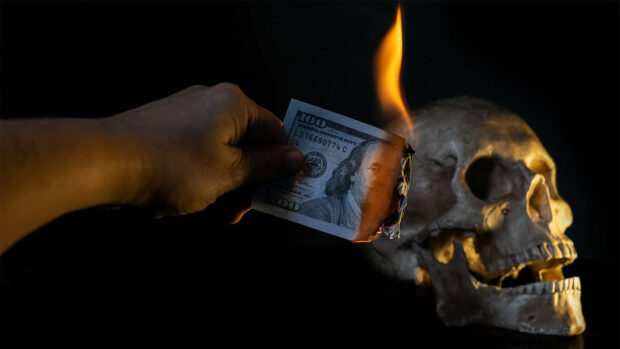It’s always cheaper to cook at home. But that doesn’t mean you can’t treat yourself and save money.
This past year, Americans have been forced to eat the highest food costs in history.
The Department of Agriculture recently released its Food Expenditure Series, an in-depth report that measures how much it costs to eat in this country. Just because Inflation, labor costs, and supply chain issues are chewing through your food budget doesn’t mean you can’t enjoy a meal out.
From easy planning to restaurant industry specific, here are tried and true ways to save money while dining out.
Everything in moderation
Americans spend about 13% of their income on food and have for years, says BLS data. Last year, we spent nearly 21% more eating out than we did eating at home – so for every $100 grocery bill, Americans spent an additional $120 at restaurants.
Being obsessively frugal is about as effective as going on a crash diet to lose weight. You can keep it up for a little while, but eventually, you’ll get sick and tired of constant denial and go on a binge, whether that’s eating an entire chocolate cake or going on a spending spree.
Instead, try mixing responsible habits with occasional indulgences.
“Dining out” doesn’t always translate to three courses at a white-tablecloth restaurant. For many people, it means hitting a fast-food or fast casual dining outlet several times a week. This is where the costs really add up.
US Foods, a major national distributor for restaurants and foodservice operators, polled over 1,000 Americans and found that most diners spend anywhere between $11 and $30 on a meal out. Seven out of ten claim they eat out because they “don’t feel like cooking,” not because they’re wanting to socialize or celebrate.
When fast food becomes a significant part of your weekly routine, those bills add up.
Planning ahead
Start making meals at home, from something as simple as picking up a rotisserie chicken and a bagged salad to cooking up a batch of chili to cover one dinner and a couple of lunches.
Cooking every night can get old, though, and eating a brown-bag lunch in the cafeteria or at your desk gets boring. Find a happy middle-ground where you eat at home as much as you can and then dine out at quality places on special occasions.
If you spend an average of $300 a month on dining out, aim to save half of that to put toward your debt or other financial goals, and spend the rest on going out when you can really enjoy it instead of just grabbing something because you didn’t plan dinner.
Here are some tips for getting the most out of your restaurant dining experience:
- Buy gift cards below face value – During the holidays lots of business offer gift card deals. If it’s a place you frequent often, get a few.
- Ask for a discount – Military, teacher, and student discounts are common. Also check for specials offered to kids and senior citizens.
- Join the club – Take a few minutes to sign up for membership emails or loyalty clubs that provide digital offers for frequent visits.
- Use coupons – Go through your local pennysaver or discount flyers and see if there are any good deals on new restaurants.
- Get a birthday discount – Most people go out for their birthday. See if they have a discount (or at least free dessert).
- Share a meal – If you know portions are large, why not share the calories? Or save half as leftovers and eat them for lunch the next day.
Grabbing a drink
Going “where everybody knows your name” is a popular way to unwind after a busy workday, but hitting the bar may be hitting your wallet a little too hard.
Mike Meadows, a restaurant manager and longtime bartender in the city of bars – New Orleans – says the average drink tab these days is about $25 per person. Frequent a bar twice weekly? That adds up to $200 a month and $2,400 a year on alcohol purchases alone.
But you don’t have to give up your favorite bar stool altogether to save on drinking…
Find a good happy hour
If you enjoy grabbing a drink with your colleagues after work, you need a good happy hour. “Not all happy hours are created equal,” Meadows says. “Some deals are just there to get you in the door.”
To find the best happy hour, start by checking the timing. On the surface, a happy hour from 3 p.m. to 7 p.m. seems like a great deal – four hours of cheaper drinks — but it won’t matter much if you get out of work at 6 p.m. Instead, look for one starting around the time you get off to maximize the specials.
Also, look for happy hour specials that combine meal deals – like smaller plates offered at a cheaper price than full-priced menu items.
Skip the tab
Just say no the next time a bartender offers to open a tab.
Meadows says “having an open tab makes it too easy to just say ‘put it on my tab’ and stop tallying how much you’re really spending.” If you get carried away – or offer to buy too many rounds for your friends – you’ll end up with a big surprise when the check comes.
Instead, Meadows always pays for his drinks in cash as he goes. That way, he can “easily stick to his budget.”
Order smart
When it comes to ordering, what you choose will make a small difference to your taste buds and a big difference to your wallet.
For beer, Meadows says to order what’s on draft, not in bottles. “You can get more than 200 beers out of a keg,” he says, so bars offer better deals on draft.
For mixed drinks, “always tell the bartender you want well,” Meadows says. When it comes to bar hierarchy, there’s top shelf, middle range, and well. And while it falls in last place, it could “save you $5 to $12, depending on what you order.”
If your group is in the mood for wine, “always order the whole bottle,” Meadows says. “You can usually get five glasses out of a bottle, and bottles are typically priced at four glasses.” Sharing a bottle shares the savings.
Know how to tip
“Tipping $1 per drink is industry standard,” Meadows says. Tip in cash as you go so you can keep your budget in check. You may want to tip extra if you order a complicated cocktail or receive exceptional service.
If you do decide to tip at the end, don’t treat your drink tab like a restaurant check.
“At a restaurant, you’re tipping based on a full-service experience, and 20% is totally reasonable,” Meadows says. But when you get to the bar, “that doesn’t always make sense.” If you have a $50 bar tab, 20% would be $10, but you may have only ordered six drinks. That 20% would be more than the industry standard for bars.
When you earmark extra money for dining out at a restaurant, always figure in a 20% tip. If you can’t afford to tip your server at all, you don’t have enough money to go out.
Spending and saving
The key to tightening discretionary expenses is finding the right balance between mindless food spending and penny-pinching scrimping. Without a few indulgences in your budget, you’ll never stick to your financial plan.
Draw up a budget that includes groceries so you can prepare most meals at home. In your budget, set aside an amount for eating out. Prioritizing where your money goes will help you regain control and increase your financial leftovers.
If you get realistic about enjoying meals out, you make the most out of your spending and saving. This way, you can have your cake – at home – and eat it out, too.







